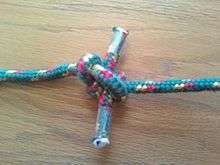Harness bend
| Harness bend (B) | |
|---|---|
 | |
| Category | Bend |
| Typical use | Joining two ropes |
| ABoK | #1474 |
The harness knot is a general purpose bend knot used to join two ropes together. The knot can be tied under tension and will not capsize.[1][2]
Tying
The harness knot is essentially two half hitches each made by one of the two joined ropes, around the other ropes body. The ends get caught in between the two ropes and the two half hitches, at the elliptical eye in the middle of the knot.
There are two ways to tie this bend: type A with ends pointing in the same direction, and type B with ends pointing in opposite directions. The starting side of one of the half hitches has to be different, in order to have the ends approach the elliptical eye in the middle, from the prescribed direction.
- Harness knot A with ends pointing to the same direction - untightened
- Harness knot B with ends pointing to opposite directions - untightened
Relationship to other knots
The harness knot type A is an unfinished Fisherman's knot (or even a Double fisherman's knot): the end needs to go through its own half hitch (twice) to form a (double) overhand knot.
The harness knot type B is an unfinished Reefer bend: The ends need to go through the opposite half hitch, to be lined up with its own rope body.
The harness knot type A is an unfinished Blood knot: The half hitches need to take one or several turns around both ropes before going through the eye in the middle.
All these knots are more secure than the harness knot but they are not as easy to untie.
 From harness knot B to Fishermans bend: ends through own half hitch
From harness knot B to Fishermans bend: ends through own half hitch From harness knot A to Reefer bend: ends through oppsite half hitch
From harness knot A to Reefer bend: ends through oppsite half hitch From harness knot B to Blood knot: ends take full rounds around both ropes before the half hitch
From harness knot B to Blood knot: ends take full rounds around both ropes before the half hitch
See also
References
- ↑ "A-Z of Knots: G-H". Scouting Resources. Retrieved 2009-11-01.
- ↑ "Bends: The Harness Bend". Helsinki.fi. Retrieved 2009-11-01.
